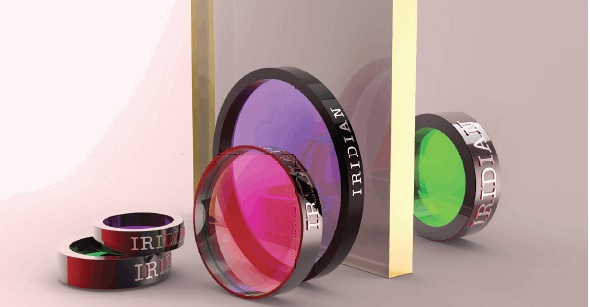Infrared (IR) sensing uses infrared-sensitive optical components to detect light in the IR region of the electromagnetic spectrum. IR sensing is now widely used in motion detection, machine vision and industrial automation, agriculture, and medical applications1 as it allows for the visualization of complementary information to visible imaging approaches. For example, infrared machine vision applications can be used for fault inspection in photovoltaics and quality control in manufacturing.2
This blog post will explore what IR radiation is, how IR sensing works and the typical optical components used, and an outlook on how Iridian’s product range can help you with your IR sensing applications.
What is Infrared (IR) light?
The IR region of the electromagnetic spectrum is the wavelength region longer than the visible but shorter than radiowaves. The IR region is typically subdivided into near-infrared (~ 0.75 – 1.4 µm), the short-, mid-, and long-wavelength regions, and the far infrared (~ 15 – 1000µm). These sub-classifications are useful as different optical technologies are required within the different wavelength ranges.
One of the most useful elements in IR sensing is that any object with a finite temperature will emit IR radiation. Whereas with visible light, the detection of an object with a camera requires sufficient illumination and direct line of light, IR images can be used to ‘see through’ certain objects as well as recover temperature information on the object.
How do IR Sensing Optics work?
A completely passive IR sensor will consist only of an IR-sensitive detector. Excitation of the sample of interest with a radiation source is not required due to the object’s thermal emission of IR light. Typical sensor types include pyroelectric sensors, but some progress is being made on the development of IR-sensitive phosphor-based sources.2 The sensor type will need to correspond to the particular wavelength region in which the device will be operating.
Often a series of optical filters will be used in an IR sensor. This includes longpass, shortpass, bandpass, and interference filters. Filters are used for a number of purposes in IR sensing devices. Often, this ensures transmission of only the spectral region of interest so the device does not become saturated by any unwanted wavelengths. Filters can also be used for the attenuation of strong signals or to improve signal-to-noise ratios and signal contrast.
Midinfrared filters are commonly used in astronomical and remote sensing equipment. A series of filter types may be integrated into telecommunications devices to avoid cross-talk between communications on different frequency ranges.
Longpass filters: Longpass filters are normally defined by their cut-on edge, which is the wavelength below which all other wavelengths of light will be blocked.
Shortpass filters: Shortpass filters are the inverse of longpass filters and are a type of edge filter that allows shorter wavelengths to be transmitted while all longer wavelengths are blocked.
Bandpass filters: Bandpass filters are defined by their central wavelength, which determines which region of the spectrum they allow to pass through. Bandpass filters have a full-width half maximum which determines how broad the transmitted spectral region is.
Interference filters: Interference filters are sometimes called dichroic filters, and they allow for the reflection of one or more spectral bands and the transmission of all other wavelength regions. Unlike most filters that absorb all wavelengths that are not transmitted, interference filters instead separate spectral mixtures through reflection and transmission. An interference filter may also have longpass, shortpass, or bandpass characteristics.
Some important properties of filters are the wavelengths of the cut-on and cut-off points, the contrast between the transmitted and blocked regions, and the steepness of the blocked region.
In conclusion, when designing IR sensing, it is essential to consider the properties of the optical components, particularly if the sensitivity to weak signals is important, so any unwanted spectral contributions must be filtered out. High-quality filter design can improve device performance and allow IR imaging to be performed over selected wavelength regions.
Iridian Optical Filters
Contact Iridian today to find out how their extensive expertise in the development of custom IR filters or off-the-shelf solutions can benefit your application. Enhance the signal-to-noise and improve acquisition times with the right filter collections and enjoy the maximum benefits that IR sensing technologies offer, whether for medical diagnosis or process automation.
References and Further Reading
- Nicolo, G., Guzman, A. De, Fang, M., Liang, C., Bao, Z., Hu, S., & Liu, R. (2020). Near-infrared phosphors and their full potential: A review on practical applications and future perspectives. Journal of Luminescence, 219, 116944. https://doi.org/10.1016/j.jlumin.2019.116944
- He, Y., Deng, B., Wang, H., Cheng, L., Zhou, K., & Cai, S. (2021). Infrared machine vision and infrared thermography with deep learning: A review. Infrared Physics and Technology, 116, 103754.

